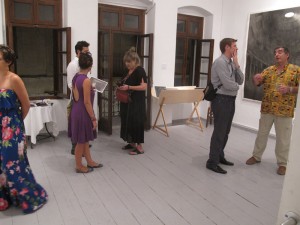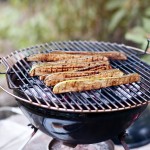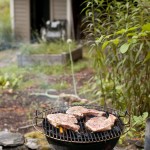I arrived in Pistoia Friday afternoon after a leisurely train ride through the Apennine Mountains from Faenza. The day began with pouring rain in Ravenna which slowed and ended as I pulled into the Faenza station. The remainder of the journey was shot with bright sun arcing through the kind of blue-grey clouds one only sees in high altitude geographies. As we passed through Ronta, Borgo di San Lorenzo, Vaglia, La Luna and other small towns I was struck how these mountain communities all have something in common. Even Leadville, Colorado has a similar feel. I hypothesize that it is the separateness of these communities from the larger populations. Like islands, they exist on the trade routes of other city’s fortunes, whistle-stops along the way from one place to another.
As the iron rails wound downhill the landscape smoothed from sharp, stony teeth and spiked conifers to a rolling ruggedness covered with magnolias, plane trees and umbrella pines. As I arrived in Firenze Santa Maria di Novella Stazione, I was struck by a memory from the early 1990s, the first time I pulled into this place, after an overnight ride from Luxembourg City. The station hasn’t changed all that much and still ranks as one of my favorite train hubs. I can go anywhere from Florence, anywhere the compass points.
In his essay ‘Fate’, Emerson discusses education, the ability to teach and how at times we seem to be bound in a cycle of superstition. He affirms his cynicism, with which I identify. He writes,
“We are incompetent to solve the times. Our geometry cannot span the huge orbits of the prevailing ideas, behold their return, and reconcile their opposition. We can only obey our own polarity. ‘Tis fine for us to speculate and elect our course, if we must accept an irresistible dictation.”
If Emerson sounds cynical, then perhaps he is. Despite the open-minded nature and the spiritual axioms of the transcendentalists, I have found through my readings that Emerson was a realist and when, let us say, confronted by an unmovable obstacle, he would accept this as fact and walk away. He talks of this reality in the above-quoted text. People can learn only when they are willing to learn and only what they want. If I remain open to all of the sights and sounds around me then I can learn more from the whole of the map than I would if I were to concentrate on one small area. If, for example, I had disembarked at Borgo di San Lorenzo last Friday instead of taking the whole journey to Firenze, then my Weltanschauung would have consisted of less than what I am currently willing to entertain. As beautiful as the scenery is in that small town, it is not the entire world, nor my entire experience. I have to be willing to be taught, to stay on the train if need be. That is not to say that cannot jump off and get on as my heart demands. I just have to remind myself that there is more to see down the line.
And so Emerson arrives at the Villa Rospigliosi, hands behind his back, ruminating in his clear New England voice. I imagine he would have liked this place, with its running fountain, olive groves, and roses. He would have enjoyed meeting the students and faculty of the Aegean Center. Like him we are here on a small island of thought, day-tripping to other stops along the line. I must not forget the larger map, the grander cartography, for even if I cannot see it at times it is there, as big as life.
JDCM





